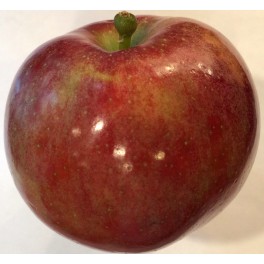McShay Apple
The McShay apple is another excellent fresh eating apple, very crisp and juicy.
Excellent for: Fresh eating; Sauce
ID-31A
More info
An excerpt from HortScience, December 1988
'McShay' Apple
'McShay' is an attractive, excellent quality apple (Malus xdomestica Borkh.) with field immunity to apple scab. The fruit is similar in color, flavor, and texture to 'McIntosh'. 'McShay' is named in honor of the late J. Ralph Shay and is a late fall dessert apple well-adapted to Oregon's Willamette Valley. 'McShay' is the ninth cultivar to be released by the cooperative apple breeding program of Indiana, Illinois, and New Jersey Agricultural Experiment Stations.
Origin
'McShay' originated from the cross of 'McIntosh' x PRI 612-4 made in 1962 in a commercial orchard in Michigan City, Ind. The complete pedigree is shown in Fig. 1. Seeds were sown in the greenhouse and seedlings inoculated with Venturia inaequalis (Cke.) Wint. (1). Resistant seedlings were planted at the Purdue Univ. Horticultural Farm in 1963. 'McShay' was selected when it first fruited in 1970. Scions were sent to Oregon State Univ. (OSU) and topworked onto an existing seedling tree in Feb. 1971 and fruit were evaluated from 1974 to 1987. 'McShay' has been tested under its progeny number (PRI 1773-8), its original Purdue Univ. location number (CAR7TI8), and its OSU Botany Farm location number (R6NRIT15).
Description
Fruit of 'McShay' are round conic and average 65 mm in diameter (Fig. 2). The fruit are attractive with a green undercolor and a dark red blush covering 70% of the surface. The skin has a light bloom and polishes to a bright shine equivalent to that of 'McIntosh', which it resembles. Fruit lenticels are white and moderately conspicuous. No russeting has been observed. The skin is thin and the flesh is fine-textured, moderately firm, juicy, and light green with a good balance of sugars and acids as evaluated subjectively by us. The fruit retains its flavor and texture for 2 to 3 months in common storage (1°C), then softens in a manner similar to 'McIntosh'. Optimum maturity at Corvallis is early September, I week after 'Prima' and 3 weeks before 'Delicious'.
Fig. 2. Fruit of 'McShay' apple.
The tree of 'McShay' is vigorous, has an upright growth habit, and a tendency to develop spurs. 'McShay' produces good annual crops. 'McShay' has been evaluated on seedling, EMLA 7, and EMLA 26 rootstocks, with the latter being a highly desirable and productive combination.
The tree flowers after 'McIntosh' but before 'Rome Beauty'. It produces viable pollen, but cross-compatibility tests with standard cultivars have not been performed.
'McShay' carries the Vf gene from Malus floribunda Sieb. 821. Leaves and fruit are field immune to the apple scab organism [Venturia inaequalis (Cke.) Wint.]. Leaves are susceptible to powdery mildew incited by Podosphaera leucotricha (Ell. & Ev.) Salm. In the absence of fungicidal sprays mildew develops, but the trees retain their foliage until late in the fall. No fruit infection has been observed even when foliar infection has been severe.
The following detailed description follows Zielinski (2) and uses color designations according to the Royal Horticultural Society Colour Chart, issued by the British Color Council in collaboration with the Royal Horticultural Society of London.
FLOWER
-
- Pedicel: 20 mm in length.
- Corolla: 40 mm in diameter at anthesis.
- Color: Spirea Red 025/1 (bud) to Phlox Pink 625/2 (open flowers).
- FRUIT
- Shape: round-conic, slightly oblique, regular.
- Size: axial diameter 64 mm to 67 mm; transverse diameter 64 mm to 67 mm.
- Color: undercolor: uranium green, 63/2; overcolor: currant red, 821/1, covering 70% of the surface.
- Skin: thin, smooth, tender with moderately conspicuous white dots, no russetting.
- Stem: 20 mm, medium thickness, clubbed.
- Cavity: medium depth and width, abrupt angle at shoulder.
- Basin: medium depth and width.
- Calyx: persistent, upright, open.
- Calyx tube: cone-shaped.
- Stamens: median.
- Core line: meeting.
- Flesh:
- Texture: fine-grained, tender, juicy;
- Quality: very good, mild sub-acid;
- Color: chartreuse green, 663/3.
- Maturity season: 2 weeks before 'Jonathan', 3 weeks before 'Delicious', 1 week after 'Prima'.
- Keeping quality: retains quality and texture 2-3 months at 1°C.
- Use: very good dessert apple grown under climatic conditions of the Willamette Valley, Ore.
TREE
-
- Form: upright, vigorous.
- Leaves: ovate, single serrate margin, apex acute, base rounded, length to width ratio = 1.6.




